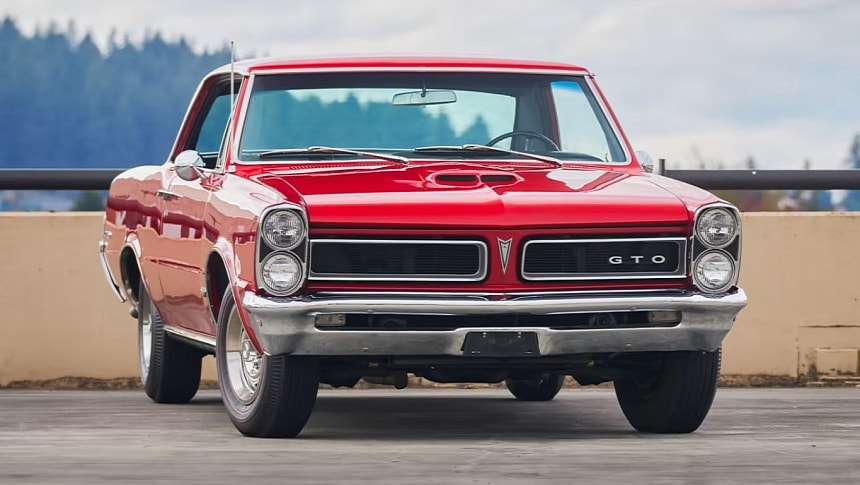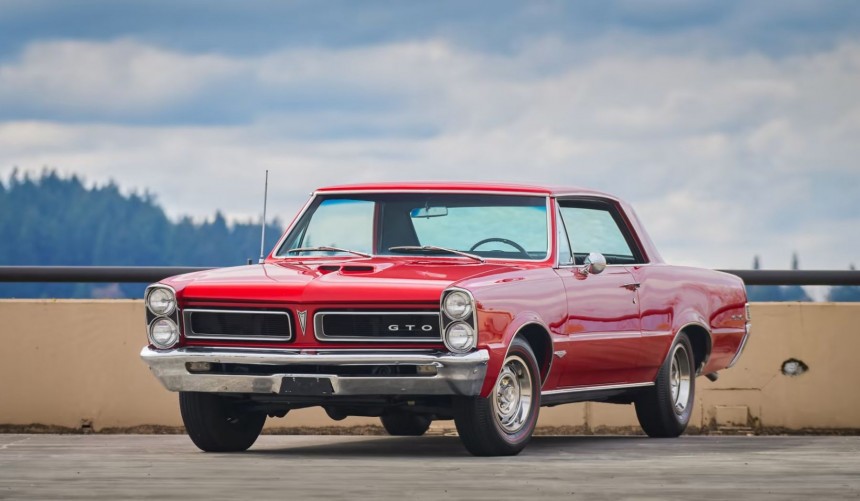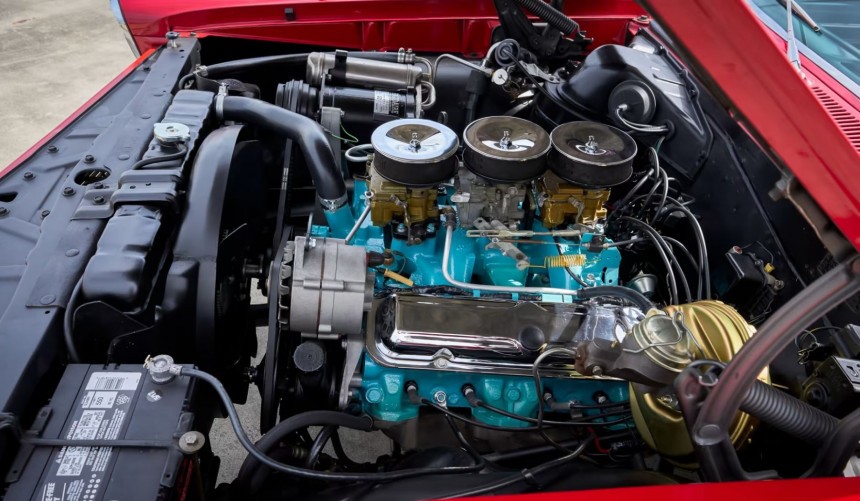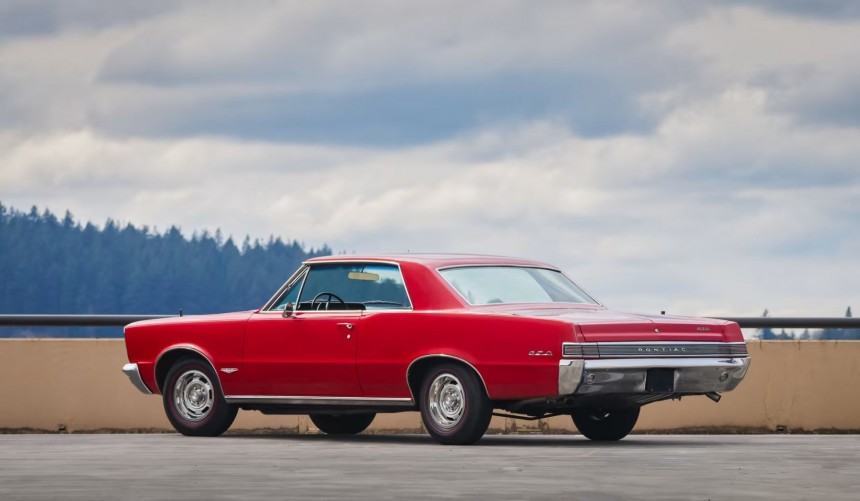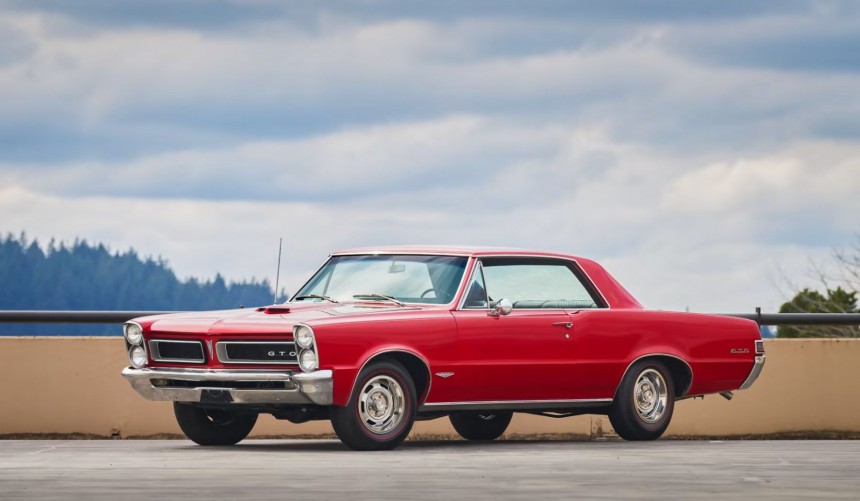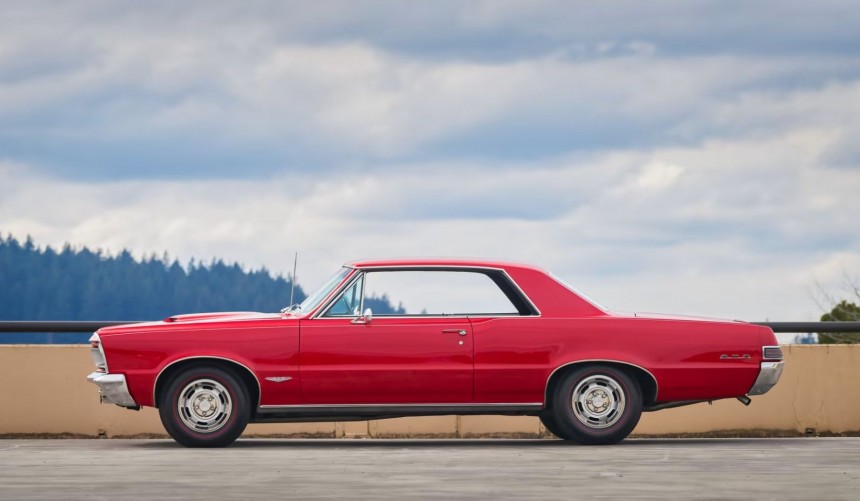In its second year on the market, the GTO continued to have no real rivals among high-performance American intermediates in terms of sales and quarter-mile performance, solidifying its muscle car GOAT status.
By the early 1960s, Pontiac was looking to improve its image by delivering exciting cars that would appeal to the lead-footed, performance-hungry youth.
Like fellow GM stablemates Oldsmobile did way back in 1949 when they made a performance-oriented V8 available in the mid-sized 88 and created an automotive icon, Pontiac decided to build their own tire-shredding intermediate.
The model chosen was the all-new, Tempest-based, second-generation LeMans introduced in 1964. More specifically, the two-door hardtop, sports coupe, and convertible versions.
For those three body styles, Pontiac launched a high-performance trim dubbed GTO, the Italian abbreviation for Gran Turismo Omologato (grand tourer homologated), inspired by the Ferrari 250 GTO.
The plan was to offer the most powerful street-legal V8 engines as part of the package and run an unprecedented marketing campaign that included homologating the car for FIA-sanctioned sports car racing, making it a genuine GTO.
The plan proved extremely successful, and by the end of the 1964 model year, Pontiac managed to sell 32,450 GTOs.
By the second half of the 1964 model year, rivaling brands were quick to answer with their own high-performance intermediates, and the muscle car era was off to an exciting start.
Though Oldsmobile and Chevrolet launched the Cutlass-based 4-4-2 and Chevelle Malibu SS a few months after the GTO, the duo was no match for Pontiac's muscle car king in terms of performance.
Still, the 1965 model year was to welcome more capable versions of the 4-4-2 and Malibu SS, plus new rivals like the Buick Gran Sport.
To defend its unofficial title of best-performing, factory-built intermediate available on the market, Pontiac made a few important changes to the 1965 GTO, which was still a LeMans performance package.
Aesthetically, the GTO and the entire Tempest lineup grew longer by 3.1 inches (79 mm), receiving what we now call a facelift.
The dual headlights were stacked vertically instead of horizontally, giving the 1965 cars a more refined yet aggressive appearance. Furthermore, the GTO package included a new non-functional hood scoop - that could be made functional via a dealer-installed option.
The visual upgrades continued inside where the dashboard design was refreshed. The GTO received an optional Rally gauge cluster that included a 120-mph (193 kph) speedometer adorned with a checkered flag, an 8,000-rpm tachometer, plus gauges for oil pressure and coolant temperature.
However, the most important upgrades were hidden from plain sight.
With the 1965 GTO also becoming about 100 pounds (45 kg) heavier, Pontiac had to increase performance, so the 389-ci (6.4-liter) at the heart of the iconic muscle car was revised.
It received enhanced cylinder heads with reworked intake passages and high-rise intake manifolds, which improved airflow.
Thanks to those upgrades, the standard 389, with its single Carter AFB four-barrel carb, was now rated at 335 hp, as opposed to 328 hp in 1964.
The optional Tri-Power 389, equipped with three two-barrel Rochester 2G carbs, got a slightly more aggressive cam and now produced 360 hp instead of 348.
As standard, the 389s were linked to a Hurst floor-shifted Muncie three-speed manual that was replaced mid-model year by the fully-synchronized HD "Dearborn" three-speed.
Optionally, stick-shift enthusiasts could choose either the wide-ratio Muncie M20 or the close-ratio M21 four-speed (both with Hurst shifters), while those who wanted an automatic could get the Super Turbine 300 two-speed automatic, which was column-shifted, unless the optional console was also checked off on the options sheet.
Chassis upgrades included a welded (instead of riveted) rear cross member, whereas the heavy-duty boxed frame of the convertible could now be optionally fitted under the sports coupe or hardtop bodies.
The double wishbone suspension front independent suspension and four-link rear setup were carried over from the 1964 model, and so were the heavy-duty springs, shocks, and front sway bar that came standard with the GTO.
Disappointingly, the brakes still comprised drums on all four wheels, and although the brake lining area increased by nearly 15%, they still did a lackluster job at stopping the muscle car, especially when equipped with the Tri-Power. That was unquestionably the 1965 GTO's Achilles heel and the only feature that was heavily criticized by most of the motoring press.
Some American manufacturers were slower at adopting disc brakes on their production cars than their European counterparts, so the GTO had to wait another two years to receive them.
While stopping the GTO was tricky, particularly after the drums heated up, attaining sports car-like speeds was a breeze.
When equipped with the Tri-Power and all the right options, like the close-ratio four-speed, the 1965 version defended the title of fastest factory-built American intermediate attained by its predecessor a year earlier.
Of all the prestigious automotive magazines, Car and Life performed the most comprehensive set of tests using a bone-stock (allegedly) Tri-Power GTO equipped with the close-ratio four-speed manual and the 4.11 limited-slip differential.
The tests, conducted with a driver, a passenger, and measuring equipment inside the car, yielded a 0 to 60 mph (97 kph) acceleration of 5.8 seconds and a top speed of 114 mph (182.4 kph).
As for the standing quarter mile, the Tri-Power GTO carrying the above-mentioned occupants and gear managed to achieve 14.5 seconds at 100 mph (160 kph).
Though its Chevelle Malibu SS 396 Z16 and Oldsmobile 4-4-2 siblings were pretty close, the Tri-Power GTO was crowned the quarter-mile king of 1965 among factory-built muscle.
With all the improvements and unrivaled performance, the GTO continued to be extremely successful in 1965.
As the model year ended, total sales of the GTO jumped from 32,450 (in 1964), to 75,352 units. Of those, the majority were hardtop coupes, followed by the slightly more expensive convertibles and the sport coupes.
Engine-wise, 54,805 GTOs left the factory with the standard four-barrel 389, while 20,547 were equipped with the Tri-Power.
Today, the 1965 is one of the most saught-after of the first-generation GTOs, so a surviving example in great shape is worth a lot of money, regardless of the engine option.
As you would expect, the Tri-Power-equipped cars are insanely expensive, currently fetching around the $100,000 mark when highly-original and equipped with all the right factory options.
Though more impressive GTOs were introduced in the years that followed, the 1965 iteration remains one of the most iconic, even these days, when the nameplate celebrates its 60th anniversary.
For a detailed review of the epic 1965 Tri-Power GTO, we recommend the following YouTube video by Muscle Car Campy.
Like fellow GM stablemates Oldsmobile did way back in 1949 when they made a performance-oriented V8 available in the mid-sized 88 and created an automotive icon, Pontiac decided to build their own tire-shredding intermediate.
The model chosen was the all-new, Tempest-based, second-generation LeMans introduced in 1964. More specifically, the two-door hardtop, sports coupe, and convertible versions.
For those three body styles, Pontiac launched a high-performance trim dubbed GTO, the Italian abbreviation for Gran Turismo Omologato (grand tourer homologated), inspired by the Ferrari 250 GTO.
The plan was to offer the most powerful street-legal V8 engines as part of the package and run an unprecedented marketing campaign that included homologating the car for FIA-sanctioned sports car racing, making it a genuine GTO.
The plan proved extremely successful, and by the end of the 1964 model year, Pontiac managed to sell 32,450 GTOs.
By the second half of the 1964 model year, rivaling brands were quick to answer with their own high-performance intermediates, and the muscle car era was off to an exciting start.
Not resting on its laurels
Still, the 1965 model year was to welcome more capable versions of the 4-4-2 and Malibu SS, plus new rivals like the Buick Gran Sport.
To defend its unofficial title of best-performing, factory-built intermediate available on the market, Pontiac made a few important changes to the 1965 GTO, which was still a LeMans performance package.
Aesthetically, the GTO and the entire Tempest lineup grew longer by 3.1 inches (79 mm), receiving what we now call a facelift.
The dual headlights were stacked vertically instead of horizontally, giving the 1965 cars a more refined yet aggressive appearance. Furthermore, the GTO package included a new non-functional hood scoop - that could be made functional via a dealer-installed option.
The visual upgrades continued inside where the dashboard design was refreshed. The GTO received an optional Rally gauge cluster that included a 120-mph (193 kph) speedometer adorned with a checkered flag, an 8,000-rpm tachometer, plus gauges for oil pressure and coolant temperature.
However, the most important upgrades were hidden from plain sight.
More horsepower
It received enhanced cylinder heads with reworked intake passages and high-rise intake manifolds, which improved airflow.
Thanks to those upgrades, the standard 389, with its single Carter AFB four-barrel carb, was now rated at 335 hp, as opposed to 328 hp in 1964.
The optional Tri-Power 389, equipped with three two-barrel Rochester 2G carbs, got a slightly more aggressive cam and now produced 360 hp instead of 348.
As standard, the 389s were linked to a Hurst floor-shifted Muncie three-speed manual that was replaced mid-model year by the fully-synchronized HD "Dearborn" three-speed.
Optionally, stick-shift enthusiasts could choose either the wide-ratio Muncie M20 or the close-ratio M21 four-speed (both with Hurst shifters), while those who wanted an automatic could get the Super Turbine 300 two-speed automatic, which was column-shifted, unless the optional console was also checked off on the options sheet.
Several chassis upgrades, but still equipped with sub-par brakes
The double wishbone suspension front independent suspension and four-link rear setup were carried over from the 1964 model, and so were the heavy-duty springs, shocks, and front sway bar that came standard with the GTO.
Disappointingly, the brakes still comprised drums on all four wheels, and although the brake lining area increased by nearly 15%, they still did a lackluster job at stopping the muscle car, especially when equipped with the Tri-Power. That was unquestionably the 1965 GTO's Achilles heel and the only feature that was heavily criticized by most of the motoring press.
Some American manufacturers were slower at adopting disc brakes on their production cars than their European counterparts, so the GTO had to wait another two years to receive them.
The quarter-mile king of 1965
When equipped with the Tri-Power and all the right options, like the close-ratio four-speed, the 1965 version defended the title of fastest factory-built American intermediate attained by its predecessor a year earlier.
Of all the prestigious automotive magazines, Car and Life performed the most comprehensive set of tests using a bone-stock (allegedly) Tri-Power GTO equipped with the close-ratio four-speed manual and the 4.11 limited-slip differential.
The tests, conducted with a driver, a passenger, and measuring equipment inside the car, yielded a 0 to 60 mph (97 kph) acceleration of 5.8 seconds and a top speed of 114 mph (182.4 kph).
As for the standing quarter mile, the Tri-Power GTO carrying the above-mentioned occupants and gear managed to achieve 14.5 seconds at 100 mph (160 kph).
Though its Chevelle Malibu SS 396 Z16 and Oldsmobile 4-4-2 siblings were pretty close, the Tri-Power GTO was crowned the quarter-mile king of 1965 among factory-built muscle.
A muscle car golden age legend that's extremely saught-after today
As the model year ended, total sales of the GTO jumped from 32,450 (in 1964), to 75,352 units. Of those, the majority were hardtop coupes, followed by the slightly more expensive convertibles and the sport coupes.
Engine-wise, 54,805 GTOs left the factory with the standard four-barrel 389, while 20,547 were equipped with the Tri-Power.
Today, the 1965 is one of the most saught-after of the first-generation GTOs, so a surviving example in great shape is worth a lot of money, regardless of the engine option.
As you would expect, the Tri-Power-equipped cars are insanely expensive, currently fetching around the $100,000 mark when highly-original and equipped with all the right factory options.
Though more impressive GTOs were introduced in the years that followed, the 1965 iteration remains one of the most iconic, even these days, when the nameplate celebrates its 60th anniversary.
For a detailed review of the epic 1965 Tri-Power GTO, we recommend the following YouTube video by Muscle Car Campy.
